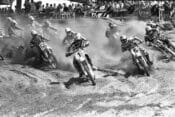Triumph admits it had the BMW GS in its crosshairs when it designed the all-new Tiger 1200. Did they hit their target?
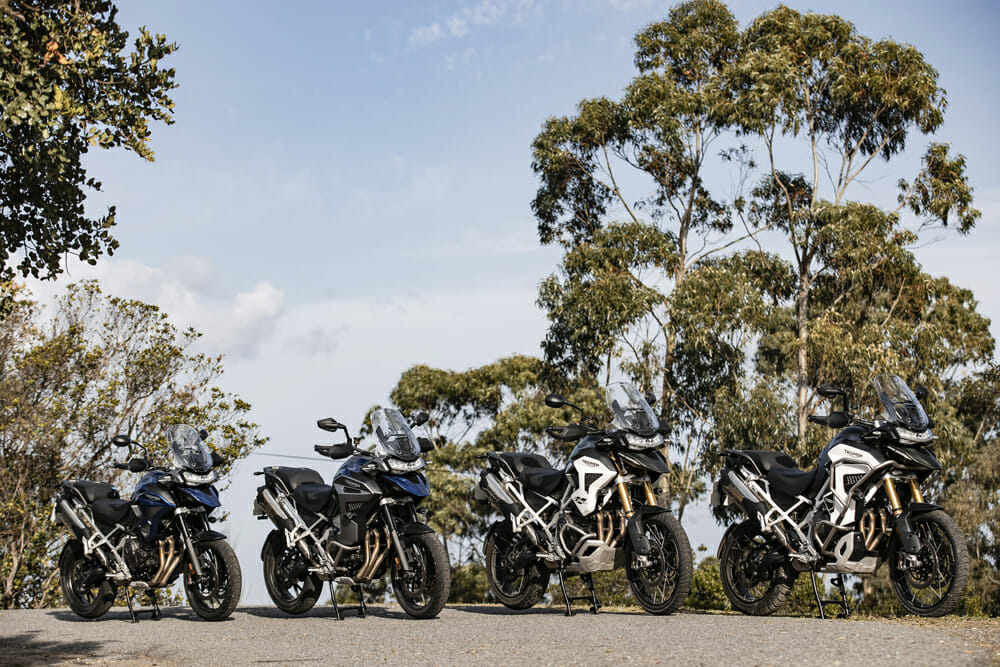
By Keith Dowdle
When we arrived in Portugal for the international press launch of the all-new Triumph Tiger 1200, the officials from Triumph made it crystal clear that their design intent for this bike was to capture a significant piece of BMW’s dominant larger-displacement ADV market share. With that in mind, the all-mighty GS was squarely in the crosshairs from their very first design drawing. The aim was to make the Tiger better in every way possible to attract new customers to the Triumph brand.
To start, Triumph wanted to produce a lighter, leaner machine. Weighing in at 549 pounds, the new T12 is an amazing 55 pounds lighter than the previous-gen Tiger 1200 and 37 pounds lighter than the GS, in similar trim. Triumph achieved the weight loss by redesigning the frame and swingarm, and by using all-new components throughout. We’ll get to those new components later—and there’re a lot of them—but for now let’s talk about the Tri-Link swingarm.
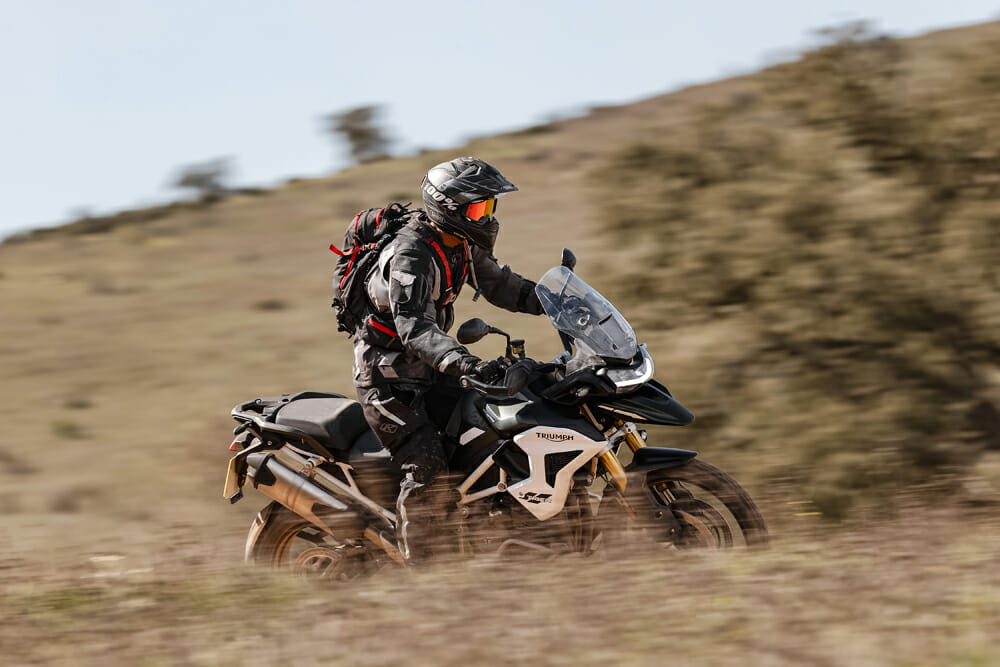
It’s lighter, stiffer and stronger than a single-sided swingarm, like that found on the GS. The design improves suspension action, giving the bike the feel of a linkage-style swingarm without the added weight. This is especially important for off-road riding, where the big machine needs to handle everything from endless stutter bumps to massive G-outs—all while keeping you confident and assured that the bike can take whatever you throw its way without tossing you over the bars.
The swingarm is assisted by Showa’s semi-active suspension, which continuously adjusts everything from ride height and damping to brake dive and rebound. It even has jump detection, where the IMU senses when the bike has left the ground and prepares the suspension for impact in milliseconds.
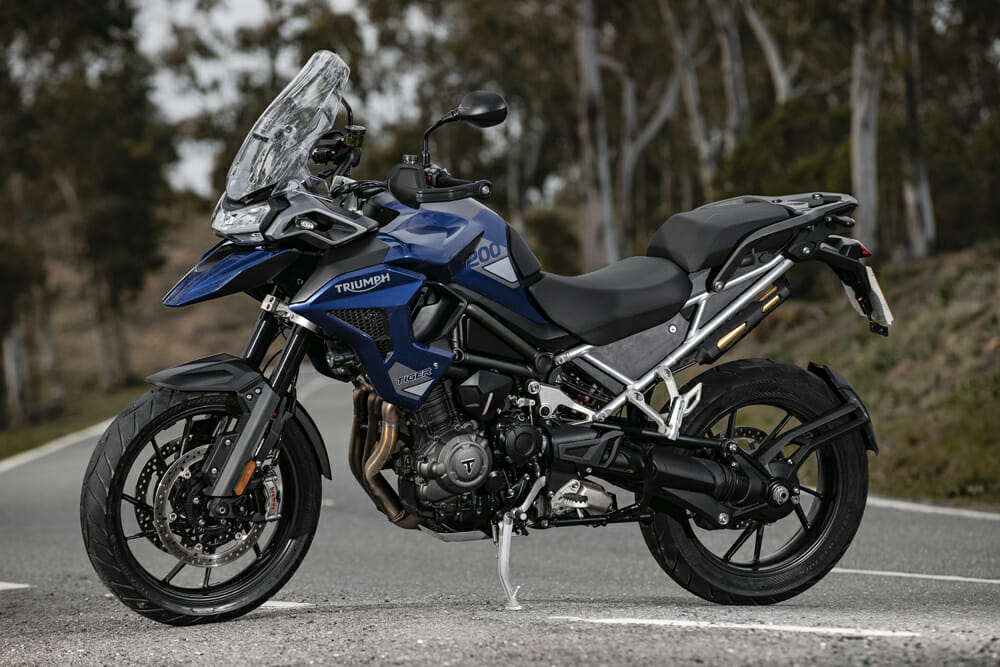
Suspension can be fine-tuned to your liking with an interface that’s easy to understand and clearly communicated via the new high-contrast seven-inch TFT dash. The handlebar controls are backlit for night riding, and you can toggle through an endless variety of screens that control everything from the six different ride modes (model dependent) and creature comforts to Bluetooth connectivity and Google turn-by-turn navigation (with help from your connected smartphone). It can even control your GoPro.
Speaking of models, Triumph offers two distinct models to choose from with varying trims to suit your riding needs and desires. The GT has three variants: the base-model GT, GT Pro and GT Explorer. Then there’s the Rally Pro and the Rally Explorer.
As is obvious from the naming convention, the Rally models are more off-road oriented, featuring spoke wheels in a very off-road-ish 21/18 configuration. The Rallys also get an added off-road riding mode that lets you fully disable both ABS and traction control. All models have engine crash bars and a skid plate, and the Rally Explorer adds additional protection up around the tank. The GT models are more road oriented, with cast wheels and a 19-inch front wheel to help the bike turn in fast twisties.
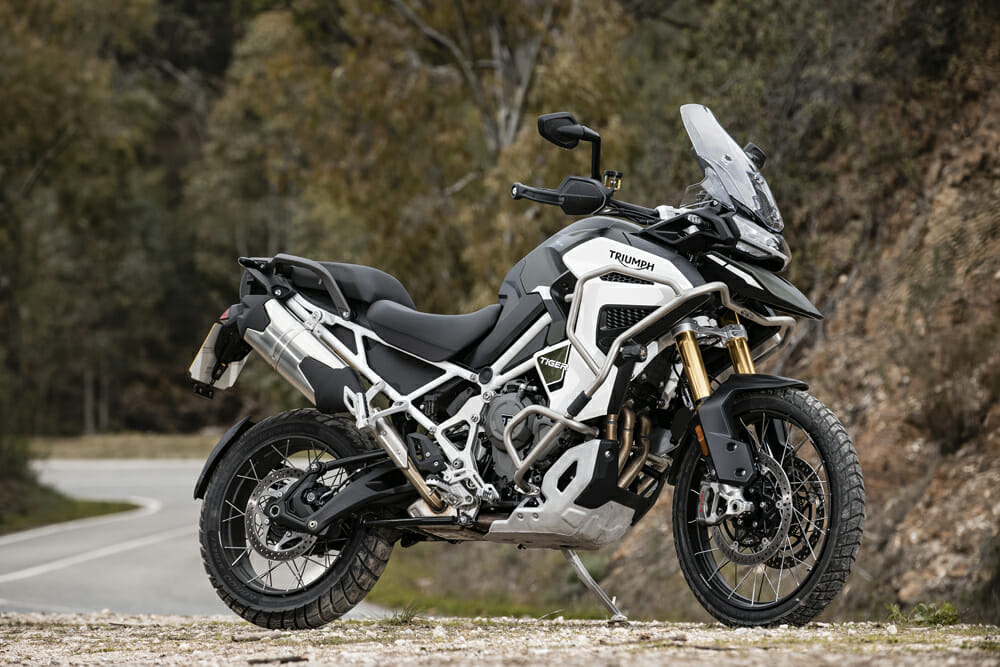
Other than the wheels and the additional ride mode, the GT and the Rally are basically the same bike—although the geometry on the Rally is slightly steeper to help that big 21-inch front wheel dive into on-road corners. Both Explorer trims get larger 7.9-gallon fuel tanks while the others get smaller 5.2-gallon tanks.
As with most bikes fitted for off-road use, the seat height on the Rally is a bit taller at 34 inches in the low position, but the seat is adjustable on both models. The Rally also has more suspension travel to handle extreme terrain.
Both Explorer trims incorporate blind-spot warning indicators under each mirror, a feature that I thought would be a nuisance, but after riding the bikes I found it to be very handy and not intrusive at all. Triumph chooses not to include front-facing radar on any of these models, stating that their customer research indicated that adaptive cruise control was not a highly desired item by consumers.
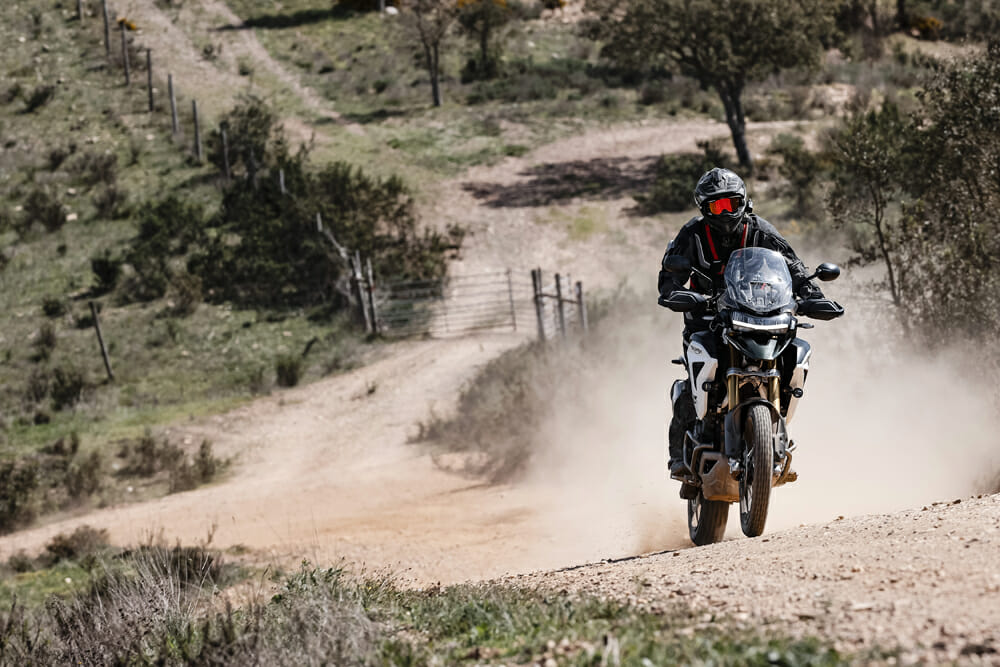
They did, however, include tons of other advanced technologies like cornering-optimized ABS and traction control, Brembo Stylema brakes, hill-hold control, keyless ignition with steering lock and fuel-cap control, lean-sensitive adaptive cornering lights, tire-pressure monitoring, heated grips—and even heated seats for both rider and passenger on the Explorer—as well as shift assist and more. Many of these features can be added as accessories if you opt for a trim that doesn’t include them.
As we left the hotel for the road ride on day one of the intro, the all-new T-Plane Triple engine with its unique 1-3-2 firing order felt a little buzzy. Triumph told us that they designed the motor, and its odd firing order, to have more torque off the bottom while maintaining the mid-range and top-end feel of this 148 bhp motor.
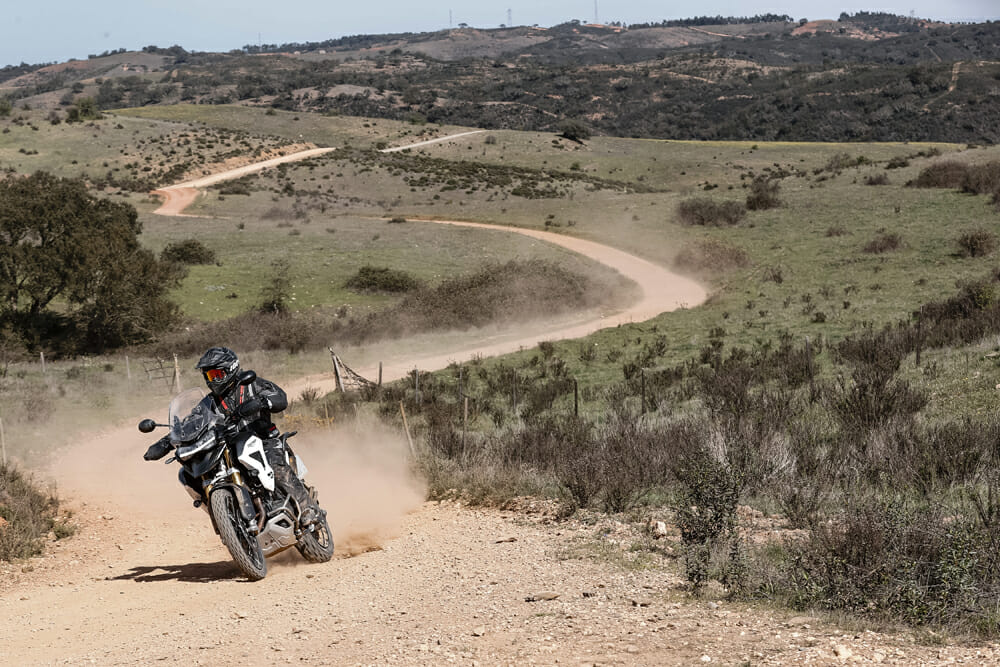
The sound of the engine is awesome, and once you get out of town and into the twisties, that alone will put a smile on your face. However, while making our way to those incredible twisting roads in the Portuguese countryside, I felt that the off-idle throttle response was lacking, and I was unable to get the cruise control to engage. The cruise control seemed clunky to me and not as easy as the GS to pop into cruise mode. The windscreen, with its super easy one-handed up/down adjustability, was a bit small for highway speed, and while there was no terrible buffeting, I did feel that a little more wind protection would give the rider just a bit more of a bubble, especially on the GT models that are intended for more long-distance highway travel.
As the roads got more twisty and the pace increased, I switched from Road mode to Sport mode and those little gripes quickly faded from my mind. All the riding modes can be infinitely adjusted, but I found the factory settings to be right on the money. The modes are noticeably different from one to the next, and you can feel the suspension and the throttle response change as you make your selection.
Initially I was in Road mode, and at slow speeds the off-throttle response seemed sluggish, but once you get past a couple thousand rpm, the motor really shines. Road would be the mode for daily round-town use and highway travel, but when you’re ready to wick it up a bit, the switch to Sport mode tightens up the suspension—and your butt cheeks—as the full 148 horses are unleashed and the fun begins.
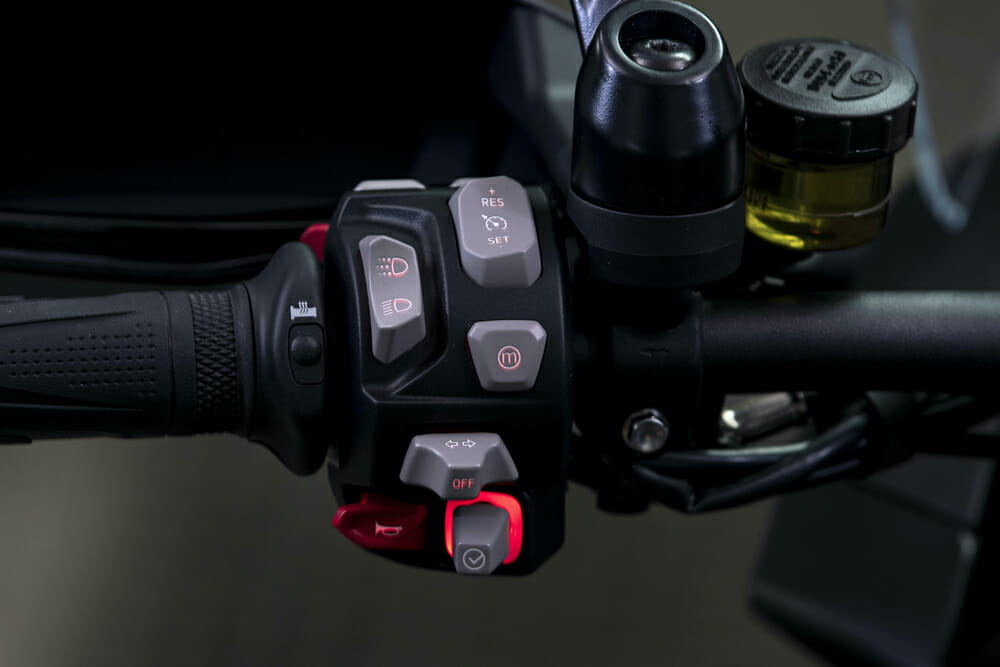
The Triumph guys kept comparing their new creation to the GS, but once in the twisties I felt like the better comparison would be to the BMW S 1000 XR, which is a motorcycle that I absolutely love on twisty tarmac. The T12’s chassis combined with the Showa semi-active suspension (and have I mentioned the quickshifter?) all work flawlessly.
The quickshift action, both up and down, is the best I’ve ever ridden. You can bang through the gears, stay on the gas, never touch the clutch, and the transmission is just as happy as you are. That, along with the deep, throaty sound of the T-Plane motor, makes this bike an absolute blast to ride aggressively.
We rode both the GT and Rally models on the road-ride day, and while the Rally is not the intended street weapon, it was the bike that I preferred on the road. The GT turns a little better, but both bikes handle well, and I found myself constantly dragging the pegs on the lower-to-the-ground GT, while the extra height of the Rally eliminated the excessive peg grinding and the 21-inch front wheel turned in just fine for me.
After I told the Triumph guys at the lunch stop about my frustration with the cruise control, they went over the operation again and I was able to make it work on the return trip without issue. More time on the bike helped me work through some of my initial gripes, and by the end of the day I was more than pleased with its performance.
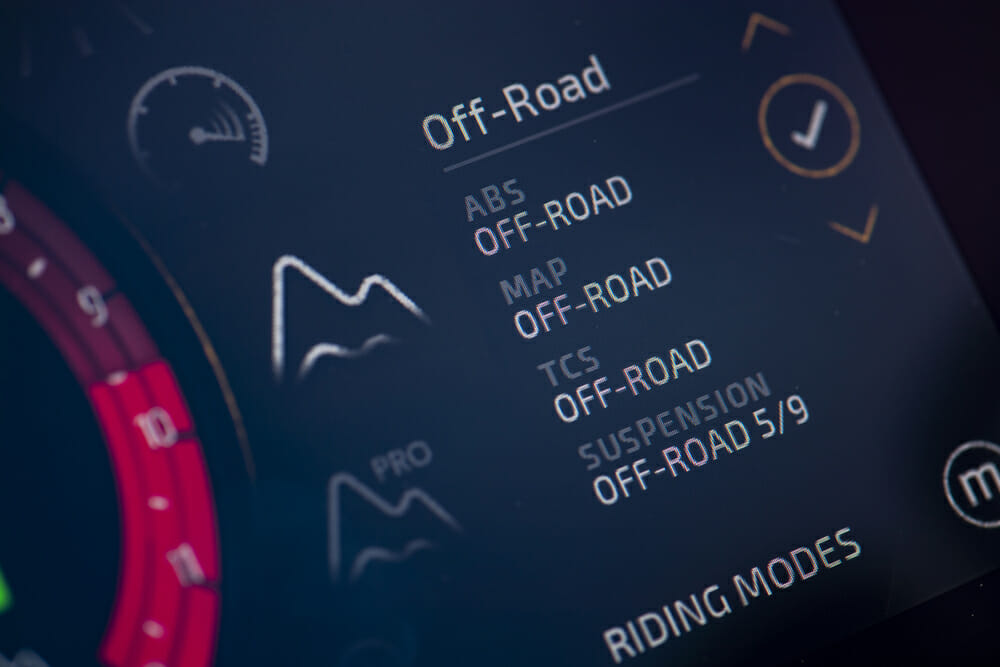
The next day we were bused to an off-road riding facility where rally drivers and riders train so that we could get an uninterrupted—no police or traffic—assessment of the off-road capabilities of the Rally Pro, which, unfortunately, was the only bike we rode off-road. Along with the other journalists, I really wanted to try some of the other models off-road, but Triumph was running wave after wave of international press through this launch, and they just didn’t have enough units to allow for additional models at this facility. With that said, we geared up and were led out by Triumph Adventure Experience Guides for a day of off-road fun.
As I’ve mentioned, Triumph was unabashed about their intent to dethrone the GS, and up to this point I had just rolled my eyes like a teenage girl (figuratively) and thought, “Whatever,” but from the moment the wheels of the big Rally Pro rolled onto the dirt, my attitude changed, and I was now thinking OMG.
Within minutes I felt at home and comfortable. With the ride mode set to Off-Road Pro (ABS and traction control disabled) and the rear end sliding side to side in a very predictable and controlled way, I was already having a ball and the day was just getting started.
If this bike is the GS killer, the dirt is where the war will be won, and the first battle of the day unquestionably went in favor of the Tiger. For full disclosure, I own a 2020 1250 GSA that I ride almost every day, and I do a lot of off-road, so I was shocked, surprised, and totally impressed with the fact that within a few miles—no, within a few hundred feet—I was riding the Tiger like it was a 450cc dirt bike rather than a giant 549-pound beast.
I was immediately more comfortable off-road on the Tiger than I am on my own GS that I’ve ridden for years. Fitted with Michelin Anakee Wild tires, which are the Triumph-handbook-approved knobby for this bike, we ripped through the beautiful Portuguese countryside like Travis Pastrana on race day. The bike handles everything from single-track to two-track with ease, and the low-end grunt of that 1-3-2 firing order chugs like a tractor as the bike climbs loose and steep terrain.
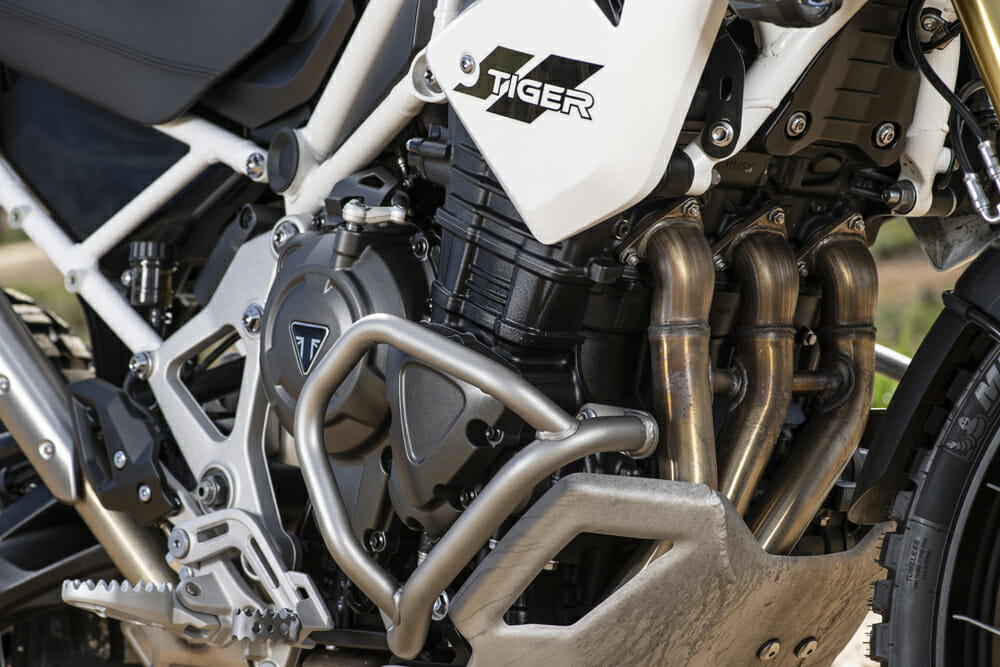
The suspension soaks up everything from small low-speed bumps and rocks to heavy G-outs. And even though the suspension will bottom out occasionally, the bike never becomes unstable, and the shock controls the rebound damping, so the rider never feels uncomfortable.
Changing to the less-aggressive Off-Road riding mode (slight ABS and traction control), the bike is toned down a bit but still very fun to ride, although the TC will catch you out if you start up a steep hill and lose traction. For aggressive off-road riding, you certainly want to stay in Off-Road Pro mode because, if for nothing else, it makes you feel like a pro. It’s awesome.
So, is the new Triumph Tiger 1200 the GS killer? Well, I’d say that the engineers at Triumph have certainly done a fantastic job with this new bike. The on-road performance is different from that of a GS, and as I said, more like the S 1000 XR, which is great if you like screaming through twisties and wheelieing out of the turns, because it’ll do that and you’ll have a blast, but I don’t think the ride is as refined as a GS on the open road. However, when the road turns to dirt, the Rally Pro will most likely leave the GS in the dust.
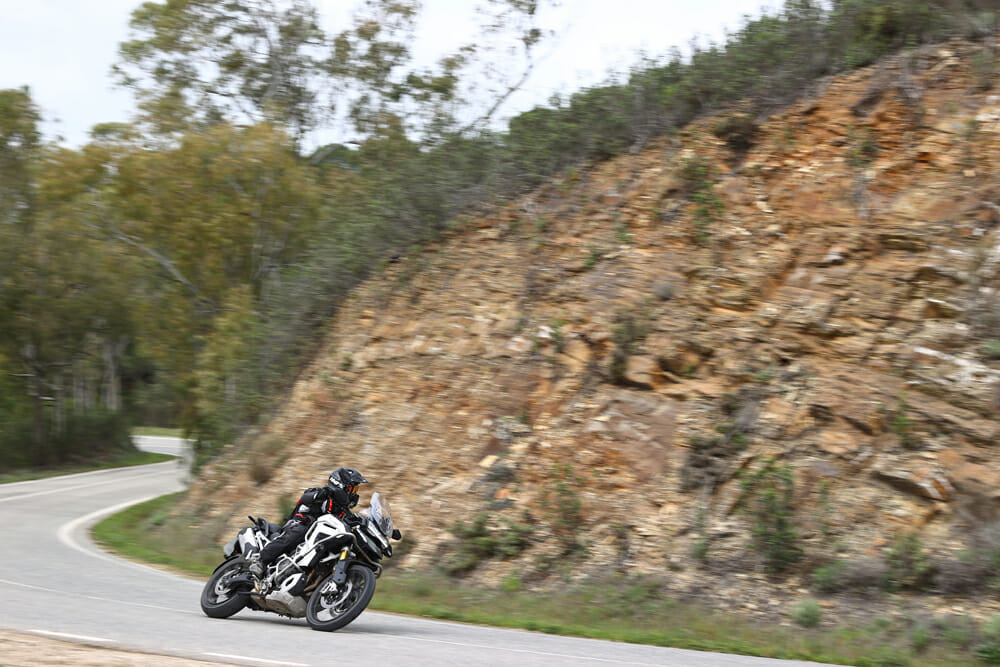
You may have heard that Triumph has announced that they’ll be coming out with a full-on dirt bike soon. It’s clear that the engineers they hired for that project have certainly had an influence on the new Tiger.
I always come home from these rides worried that it’s just going to make me want to buy another bike, and damn it, it’s happened again.
Triumph is offering a three-year unlimited mileage warranty and best-in-class 10,000-mile service intervals on all the new Tiger 1200s. The new Tigers are designated model year 2023 in the U.S. and the GT is scheduled for dealer delivery in May of this year, while the Rally is still going through U.S. homologation. Check the Triumph website for more information on colors, accessories and availability. CN
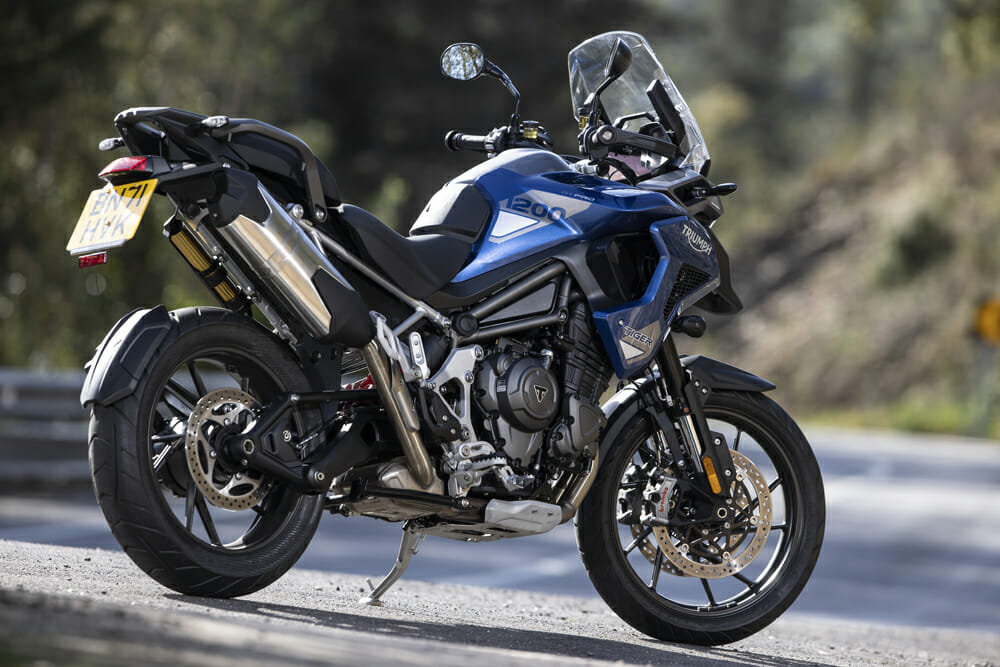
2023 Triumph Tiger 1200 GT / GT Pro / GT Explorer Specifications
| MSRP: | $19,100/$21,400/$23,100 |
| Engine Type: | Inline 3 cylinder |
| Valvetrain: | 12-valve, DOHC |
| Cooling System: | Liquid |
| Displacement: | 1160cc |
| Bore x Stroke: | 90.0 x 60.7mm |
| Compression Ratio: | 13.2:1 |
| Max Horsepower (claimed): | 148 bhp at 9000 rpm |
| Max Torque (claimed): | 96 ft-lb at 7000 |
| Fuel System: | Multipoint sequential electronic fuel injection with electronic throttle control |
| Exhaust System: | Stainless-steel 3-into-1 header system with underslung primary silencer and side mounted secondary silencer |
| Final Drive: | Shaft |
| Clutch: | Hydraulic, wet, multi-plate, slip & assist |
| Transmission: | 6-speed |
| Frame: | Tubular steel frame, with forged aluminum outriggers. Fabricated, bolt-on aluminum rear subframe |
| Swingarm: | Twin sided “Tri-Link” aluminum swingarm with twin aluminum torque arms |
| Front Wheel: | Cast aluminum, 19 x 3.0 in. |
| Rear Wheel: | Cast aluminum, 18 x 4.25 in. |
| Front Tire: | Metzeler Tourance 120/70R19 (M/C 60V TL) |
| Rear Tire: | Metzeler Tourance 150/70R18 (M/C 70V TL) |
| Front Suspension: | Showa 49mm USD forks with semi-active damping |
| Rear Suspension: | Showa monoshock with semi-active damping and automatic electronic preload adjustment |
| Front-Wheel Travel: | 7.9 in. |
| Rear-Wheel Travel: | 7.9 in. |
| Seat Height: | 33.46 – 34.25 in. |
| Wheelbase: | 61.41 in. |
| Rake / Trail: | 24.1° / 120mm |
| Weight (wet, claimed): | 529 lbs. / 245 kg / 255 kg |
| Fuel Capacity: | 5.28 gal. / 5.28 gal. / 7.92 gal. |
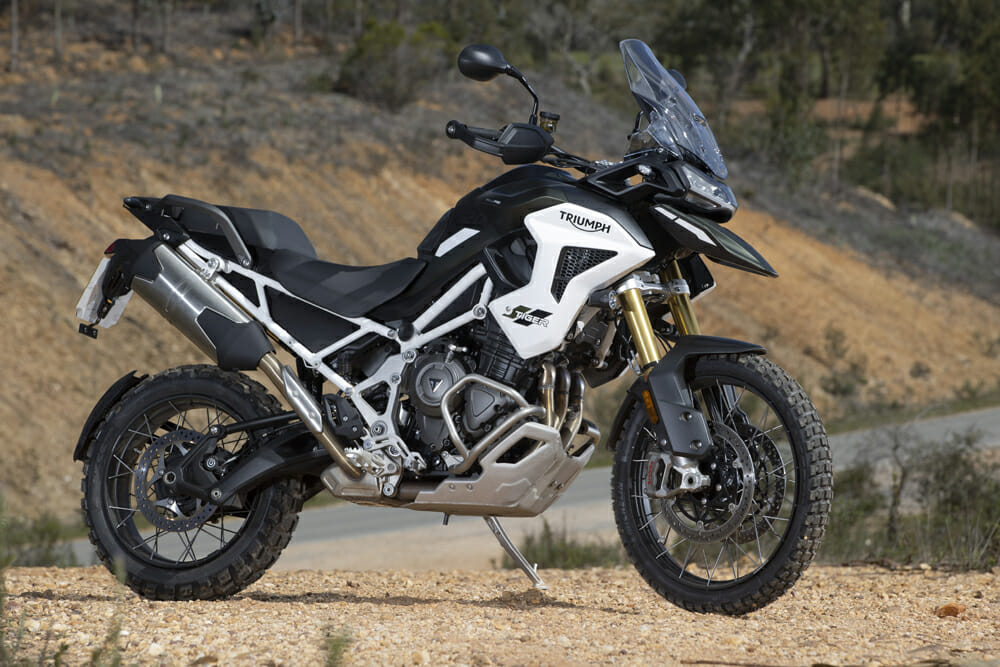
2023 Triumph Tiger 1200 Rally Pro / Rally Explorer Specifications
| MSRP: | $22,500/$24,200 |
| Engine Type: | Inline 3 cylinder |
| Valvetrain: | 12-valve, DOHC |
| Cooling System: | Liquid |
| Displacement: | 1160cc |
| Bore x Stroke: | 90.0 x 60.7mm |
| Compression Ratio: | 13.2:1 |
| Max Horsepower (claimed): | 148 bhp at 9000 rpm |
| Max Torque (claimed): | 96 ft-lb at 7000 |
| Fuel System: | Multipoint sequential electronic fuel injection with electronic throttle control |
| Exhaust System: | Stainless steel 3-into-1 header system with underslung primary silencer and side-mounted secondary silencer |
| Final Drive: | Shaft |
| Clutch: | Hydraulic, wet, multi-plate, slip & assist |
| Transmission: | 6-speed |
| Frame: | Tubular steel frame, with forged-aluminum outriggers. Fabricated, bolt-on aluminum rear subframe |
| Swingarm: | Twin sided “Tri-Link” aluminum swingarm with twin aluminum torque arms |
| Front Wheel: | Spoked (tubeless), 21 x 2.15in. |
| Rear Wheel: | Spoked (tubeless), 18 x 4.25in. |
| Front Tire: | Metzeler Karoo Street 90/90-21 (M/C 54V TL) |
| Rear Tire: | Metzeler Karoo Street 150/70R18 (M/C 70V TL) |
| Front Suspension: | Showa 49mm USD forks with semi-active damping |
| Rear Suspension: | Showa monoshock with semi-active damping and automatic electronic preload adjustment |
| Front-Wheel Travel: | 8.66 in. |
| Rear-Wheel Travel: | 8.66 in. |
| Seat Height: | 34.44 in.- 35.23 in. |
| Wheelbase: | 61.41 in. |
| Rake / Trail: | 24.1° / 120mm |
| Weight (wet, claimed): | 548.95 lbs. / 575.407 lbs. |
| Fuel Capacity: | 5.28 gal. / 7.92 gal. |
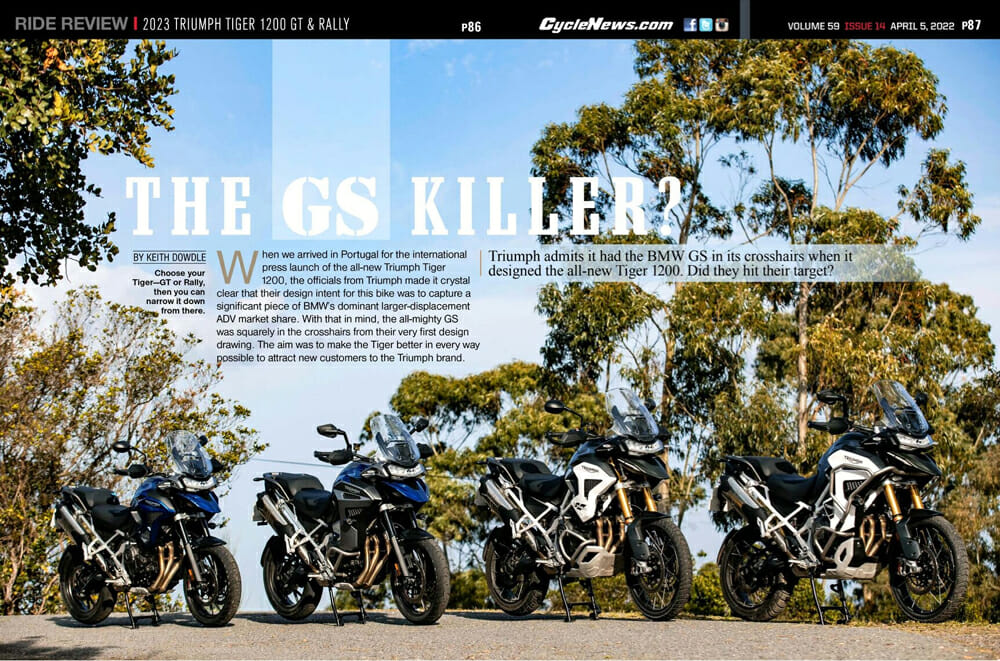
Click here to read the 2023 Triumph Tiger 1200 GT & Rally Lineup article in the Cycle News Digital Edition Magazine.
Click here for the latest Cycle News Adventure motorcycle reviews and news.
Click here for the latest Cycle News Dual Sport motorcycle reviews and news.
Click here for more Triumph motorcycle reviews and news.
